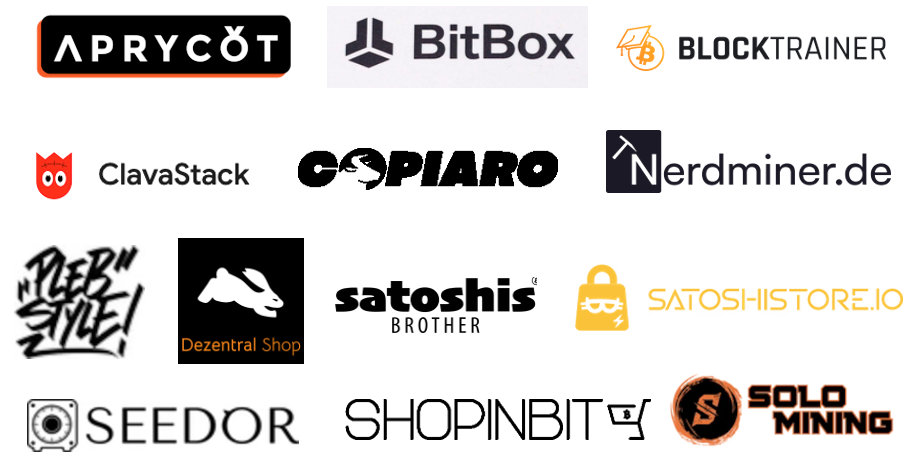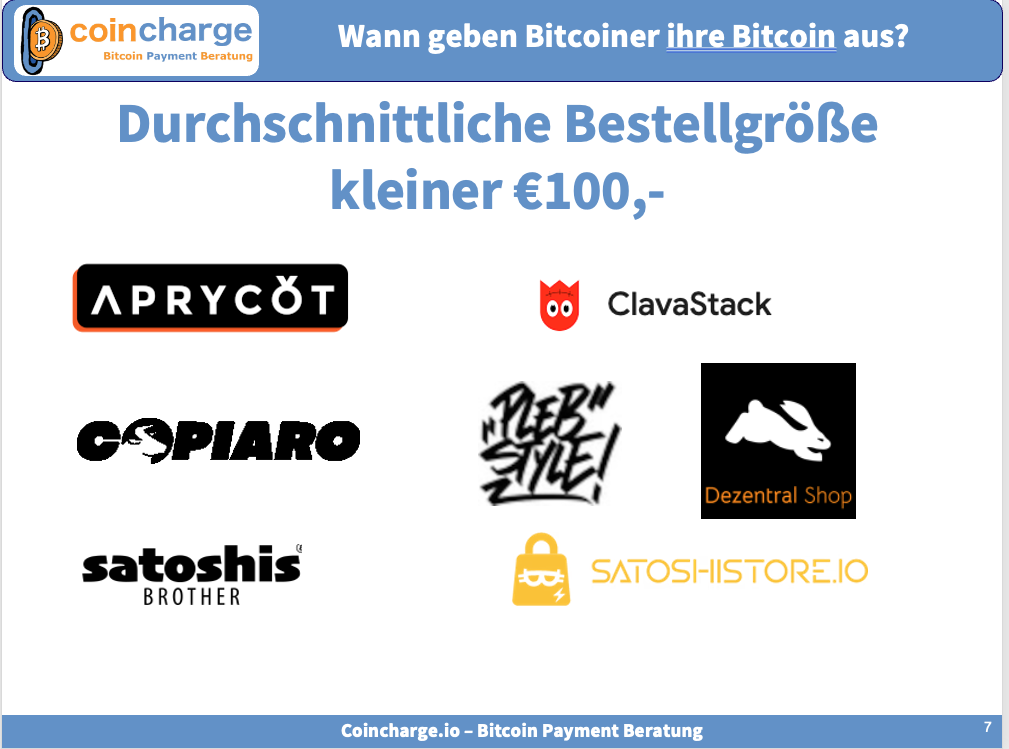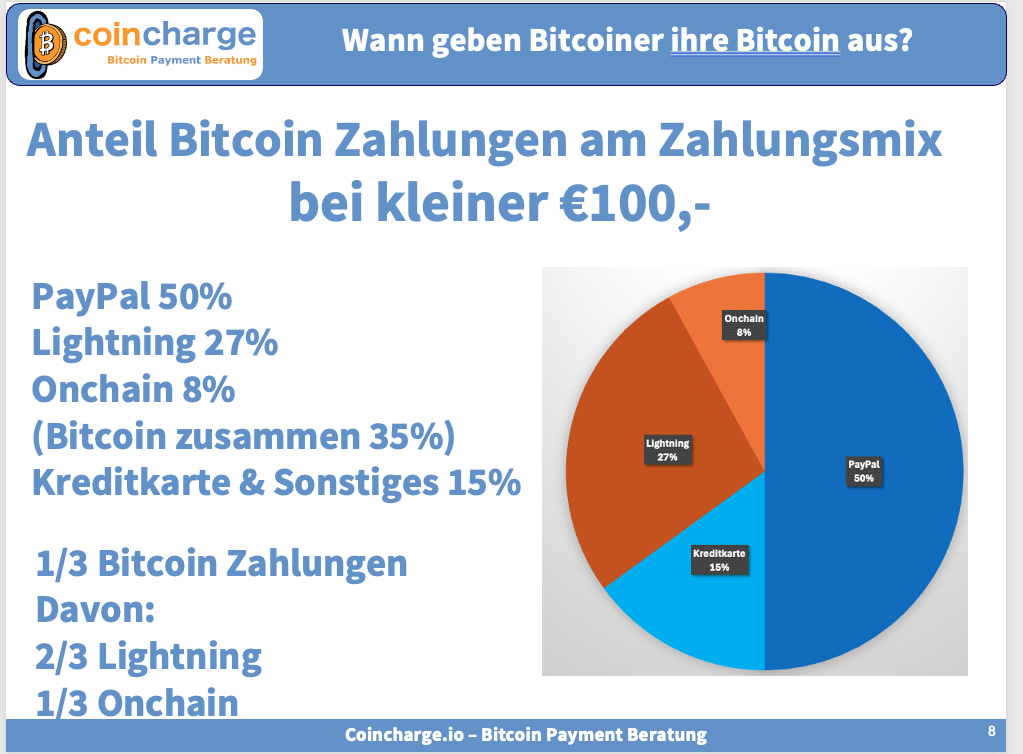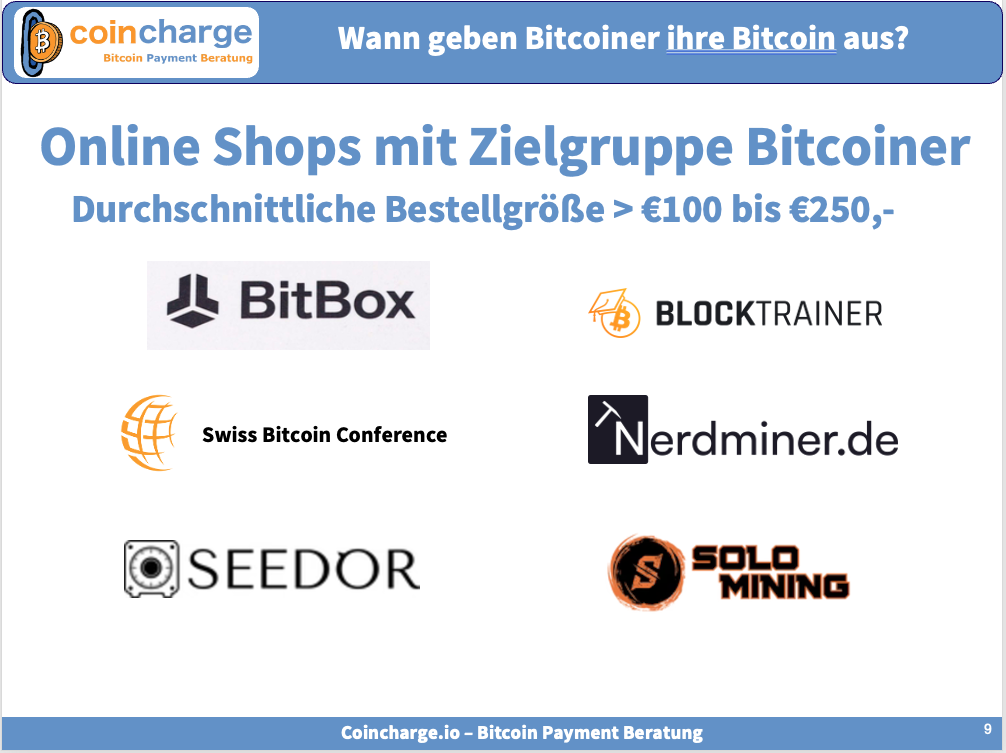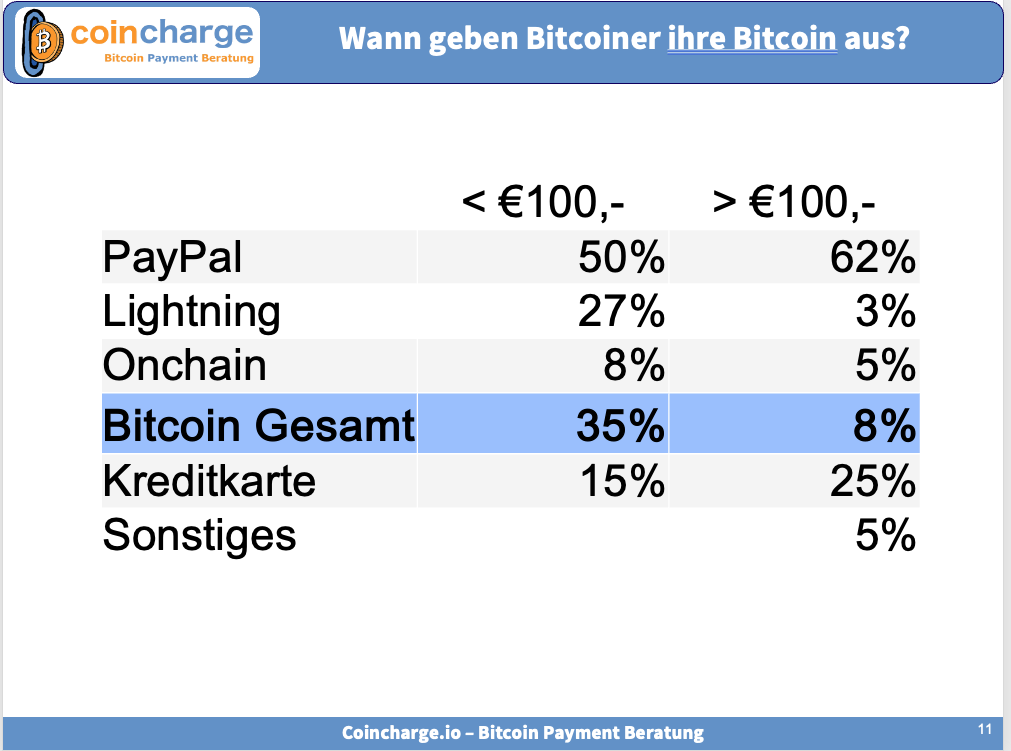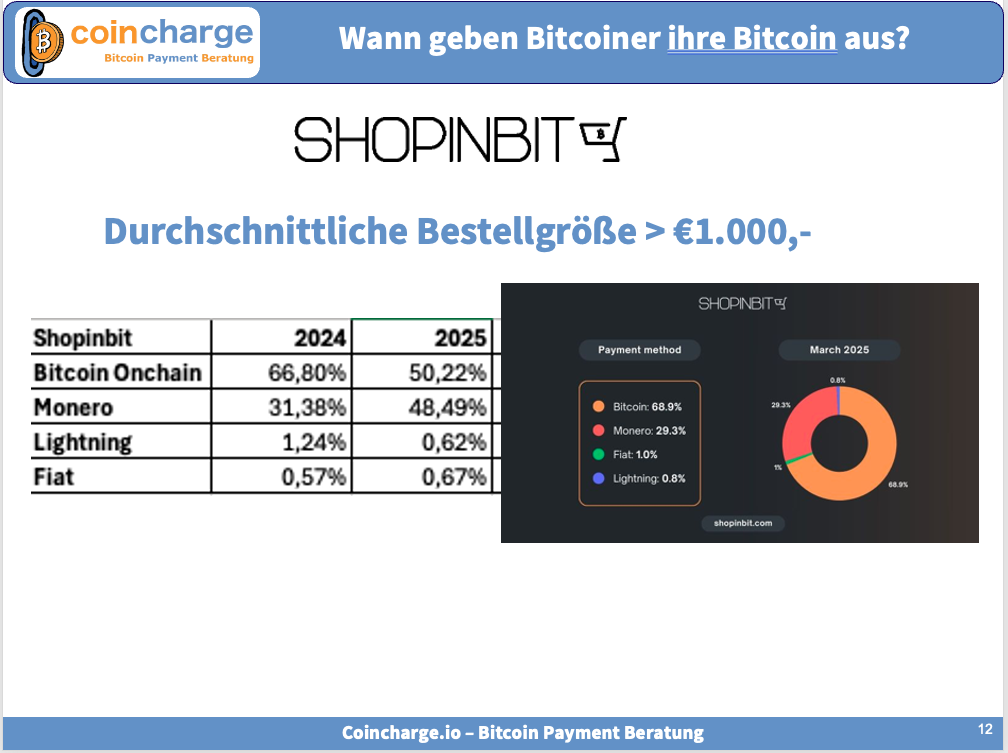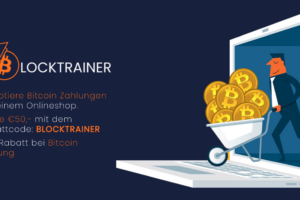When do customers pay with Bitcoin? We show real data from e-commerce. We therefore asked the most important online stores in German-speaking countries: “How do you pay?” We want to find out how many payments are made with Bitcoin and how many with traditional online payment methods such as PayPal and credit cards.
We present the answers to our survey in this article.
When do Bitcoiners spend their Bitcoin?
When do Bitcoiners actually spend their Bitcoin?
Or do they just hodl and never get paid?
We asked the most important Bitcoin online stores in German-speaking countries how they accept payment and what the proportion of Bitcoin is.
Small amounts of less than 100 euros are surprisingly often paid with Bitcoin – and mostly with Lightning!
If the price rises above 100 euros, Bitcoin use decreases sharply.
You can find out what this reveals about the payment behavior of Bitcoiners in this article.
Survey of Bitcoin transactions
Anyone who accepts Bitcoin as a means of payment will ask themselves whether Bitcoiners will also pay with Bitcoin. Or will Bitcoiners just hold on to their Bitcoin and never part with it?
We therefore asked the most important online stores in German-speaking countries: “How do you pay?” We want to find out how many payments are made with Bitcoin and how many with traditional online payment methods such as PayPal and credit cards.
YouTube video: When do Bitcoiners spend their Bitcoin?
We have published a video on the Coincharge YouTube channel with the topic“Merchant survey: When do Bitcoiners spend their Bitcoin?”
Which stores took part?
We asked the most important Bitcoin stores in German-speaking countries that specifically target Bitcoin users with their products. These stores offer Bitcoin merchandise, Bitcoin books, technical gadgets such as nodes or Bitcoin accessories such as hardware wallets.
Among other things, we asked the online stores what the average order value is and which payment methods they use. With regard to the proportion of Bitcoin payments, we also wanted to know what the ratio is between on-chain and lightning payments.
How Bitcoiners pay for amounts less than €100
First, let’s look at the online stores where the average order size is under €100. These include stores such as Apricot Media, which offers Bitcoin books, as well as stores that primarily offer Bitcoin merchandise, such as ClavaStack, Copiaro, Decentral Shop, Plebstyle, Satoshis Brother and Satoshistore.
Do Bitcoiners really pay with Lightning?
With almost 50%, PayPal is the dominant payment method. Bitcoin is in second place with a combined 35%. Two thirds of all Bitcoin payments are lightning payments and one third are on-chain payments. The remaining payment methods, such as credit cards, account for around 15%.
As a result, it can be stated that the respondents are willing to pay with Bitcoin.
The fact that Bitcoin already accounts for a third of all payments is surprising and was not to be expected on this scale.
The high proportion of Lightning payments with two thirds of all Bitcoin payments should also be emphasized.
Since the average order value is less than €100, usually between €30 and €70, it can be concluded that these are mainly Lightning testers who have loaded a manageable amount onto their own Lightning app and deliberately use it for payment.
How Bitcoiners pay for amounts over €100
This assumption is confirmed when we look at the payment mix for an average order size of over 100 euros.
These are mainly providers of Bitcoin wallets, such as BitBox, Seedor and Blocktrainer, who also offer their products. Then there are the miners from Nerdminer and Solominer as well as the tickets for the Swiss Bitcoin Conference.
Distribution of Bitcoin payments for larger amounts
The average order size here is between 150 and 350 euros.
When the price rises, the share of Bitcoin payments falls rapidly and the share of PayPal rises accordingly. Around 62% of all payments were made via PayPal, while Bitcoin only achieved a total share of 8%. The distribution between Lightning and Onchain was almost 50/50.
Credit cards and other payment methods also increased to a total of 25%.
Comparison of order sizes under €100 vs. over €100
If we compare the two results again, it becomes even clearer. But what could be the reason for this?
There is some evidence that the Lightning testers have an amount of up to €100 on the Lightning app.
If there is an option to pay with Bitcoin, the balance on the Lightning app is often used for this.
However, if the purchase amount exceeds the corresponding balance, payment with Bitcoin becomes complicated.
The Bitcoin onchain wallet must first be found and unlocked.
This is a lengthy process until you can pay with Bitcoin.
A quick and spontaneous payment is then no longer possible and you fall back on the well-known alternative payment methods such as PayPal.
Lightning payments dominate for small amounts
As an interim conclusion, it can be said that if you want to sell products to Bitcoiners, you should definitely offer Bitcoin as a payment method.
This applies to both Bitcoin Onchain and Lightning.
If the order size is less than €100, Bitcoin is very popular and very often used for payment.
In combination with a discount for Bitcoin payments, this is definitely advisable.
This also applies to stores that have an average order size of over €100, because there will also be products with lower prices in the range for which Bitcoin is popular, especially via Lightning.
High-priced products with order sizes of over 1,000 euros.
Let’s take another look at a special case: Shopinbit. Shopinbit is an online store that offers thousands of products and specializes in the so-called concierge service.
As part of this, individual shopping wishes are fulfilled, including travel and cars.
The order size is over 1,000 euros and payment is mainly made via Bitcoin Onchain and Monero.
There are also lightning payments, but these are mainly used in the regular online store for lower-priced products.
There is some evidence that the Lightning testers have an amount of up to €100 on the Lightning app.
If there is an option to pay with Bitcoin, the balance on the Lightning app is often used for this.
However, if the purchase amount exceeds the corresponding balance, payment with Bitcoin becomes complicated.
The Bitcoin onchain wallet must first be found and unlocked.
This is a lengthy process until you can pay with Bitcoin.
A quick and spontaneous payment is then no longer possible and you fall back on the well-known alternative payment methods such as PayPal.
Especially in the high-price segment, for example at car dealerships or for jewelry and watches, there is a growing interest in paying with Bitcoin.
The more the Bitcoin price rises in the future, the more long-term Bitcoin users will want to part with some of their Bitcoins and prefer to spend them rather than exchange them back into euros.
They may even be forced to pay with Bitcoin, as the regulatory requirements for Bitcoin exchanges are becoming ever stricter and legislators are demanding corresponding proof of the origin of the Bitcoins, which in some cases cannot be provided at all because the Bitcoin exchange where you bought your Bitcoins no longer exists or because proof of Bitcoin mining or a Bitcoin purchase in cash at a meetup cannot be documented.
Do Bitcoiners pay with Monero?
But why is the share of Monero so high compared to the share of Bitcoin?
Anyone who has a large number of Bitcoins on their Bitcoin wallet is reluctant to make a payment from this wallet.
Both the payment recipient and the merchant can identify the buyer and see which wallet the Bitcoins come from and how many are still in the buyer’s possession.
Accordingly, the Bitcoiner changes their Bitcoins into Monero beforehand and then pays with Monero at Shopinbit so that their privacy is maintained with regard to the number of Bitcoins they have.
Summary: Is payment made with Bitcoin?
The results of our survey clearly show that Bitcoiners are willing to pay with Bitcoin. Be it to spontaneously pay a small amount with the Lightning app, or be it because they, as long-time Bitcoiners, want to part with some of their Bitcoin by paying with Bitcoin where Bitcoin is accepted.
Even though we specifically targeted stores aimed at Bitcoiners in this survey, these are positive signals for all stores.
More and more people own Bitcoin and the longer they hold it, the more they will start to try out Bitcoin Lightning and make their first payments with smaller amounts.
Long-time Bitcoiners will eventually start to part with some of their Bitcoin and spend it where Bitcoin is accepted instead of exchanging it for euros.
There is no doubt that Bitcoin is still in its infancy as a payment method, and the competition from cash in bricks-and-mortar retail and from PayPal and credit cards in online retail is enormous.
But there are Bitcoiners who are ready to pay with Bitcoin today, and anyone who is personally convinced by Bitcoin should start accepting Bitcoin from their customers.
If you would also like to accept Bitcoin payments, please arrange an individual consultation with me.


